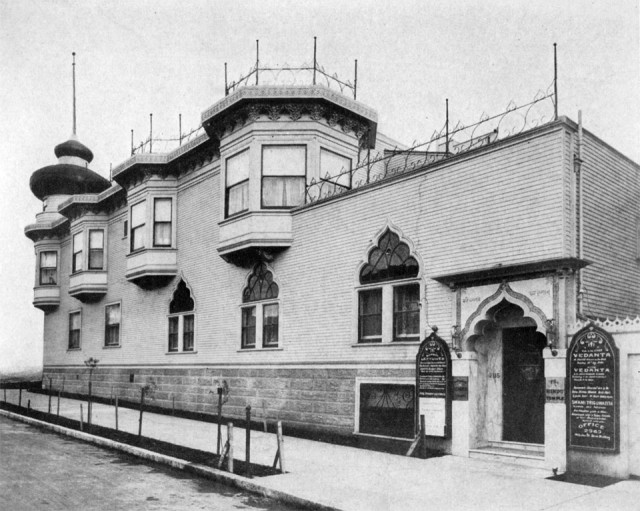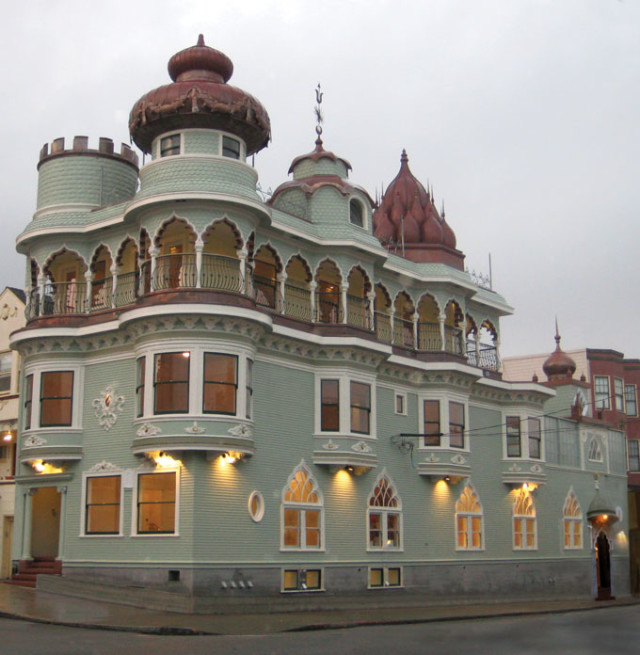
An ornate, multidomed house at 2963 Webster Street at Filbert, known as the first Hindu temple in the Western world, is being renovated. Dedicated Jan. 7, 1906, it avoided the debacle that devastated San Francisco some three months later. It recovered from a malicious bombing in 1914. And it withstood the 1989 quake.
However, the effects of time, seismic precaution, and the mandates of municipal codes called for reconstruction of its interior. Among the problems were leaking water and earthquake vulnerability. In 1906 the structure had just two stories; two years later, it acquired a third story and new stresses. Its unique exterior now takes in up-to-date retrofitting, roofing, lighting, wiring, plumbing, heating, audiovisual aids, and other improvements.
The project at the “Old Temple” of the Vedanta Society of Northern California nears its end after more than two years of work, headed by Christopher Hesson of Christopher’s Construction in Sausalito. Costs and financing are undisclosed.
The reopening date depends on completion of the work. It was supposed to be finished in time for ceremonies on Oct. 29, but they were held anyway. Swamis came from far and near to worship at the old site and 320 people attended events at the “New Temple,” 2323 Vallejo Street at Fillmore, Marianne Quinn, society secretary, related.
The Old Temple contains architectural elements of Hindu, Islamic, and Christian houses of worship plus a European castle, all superimposed on the Victorian residential style common in the early 20th century. Initially a single tower topped the temple. The 1908 building, with the extra story — surrounded by a colonnaded, Moorish-style balcony — acquired five towers. The structure now gains a basement and a real foundation.
“There was a small foundation, a foot or two at most, and it had deteriorated with time. In some places, we didn’t see any foundation at all,” said Swami Vedananda, of the society. “Now there is a reinforced concrete foundation, following all the latest earthquake codes of the city.” To allow digging for the foundation, the entire building was temporarily supported by steel beams. They had been slid through holes cut in the walls; cribbing supported the beams.
“We dug out a full floor,” Greg Patterson, master carpenter, said proudly. “We stripped the building down, added steel frames, repaired all the plaster. … It’s top-to-bottom brand-new inside. We redid the cupolas. They were made of galvanized steel. Now they’re copper.”
THE SWAMIS AND THE UNIVERSE
Swami Trigunatita conceived the idea for the building and its design. Joseph A. Leonard, architect, put the concept in blueprints. Trigunatita was the society’s third of 11 swamis, or religious teachers, all from India.
Trigunatita dedicated the temple to “the service of God … for persons of all faiths … to discover and realize that we are one; we are the children of one father. …” He called it the first “Universal Hindu Temple in the West.”
Swami Tattwamayananda, present head of the society, writes that the temple “was built as a symbol of the great Vedantic ideal that the ultimate reality is one and that every religion is an equally valid path leading to the same spiritual goal. … The symbolism of temples, as well as all aspects of temple worship, are meant to help us to eventually realize the immanent presence of God in our own heart.” Tattwamayananda calls Vedanta, to which Gandhi adhered, “Higher Hinduism.” It is a philosophical system based on the Vedas, sacred Hindu writings.
The society is a branch of the Ramakrishna Math (order of monks) and Mission of West Bengal, India. Greeting the rededication, the president, Swami Atmasthananda, wrote, “Vedanta teaches that the ultimate truth is Oneness.’ … Although it is very difficult to grasp this Oneness behind the diversified universe, still it is the same consciousness that pervades everything. …”
As Swami Vivekananda said, “Happiness belongs to him who knows this Oneness, who knows he is one with the universe.” Vivekananda introduced Vedanta to America in 1893 at the World’s Parliament of Religions in Chicago and founded San Francisco’s Vedanta Society in 1900. He died in India at 39.
Vedanta does not seek to convert people from their existing faiths. A bookstore at the New Temple sells volumes representing various religions. That temple, in use since 1959, houses the society’s main office, monastery, convent, and 160-seat auditorium. The Old Temple seats about 95. Membership is placed at about 200.
THE MORTGAGE AND THE BOMBER
Vedantists were meeting in a rented house at 40 Steiner Street when Swami Trigunatita proposed their own building. Soon members raised money and bought a plot at Webster and Filbert Streets. Construction took under five months.
Trigunatita led a rigorous, ascetic life here for 12 years, though painful ailments developed. A jolly man, he made friends with neighbors and city elite. Among his temple innovations were a print shop; a monthly magazine, Voice of Freedom; and a monastery for young men. He led them in hymns and chants on the roof or by the harbor in early morning, surprising sailors and fishermen.
Trigunatita added a third-floor apartment and balcony, hoping Swami Brahmananda, Ramakrishna president, would visit from India. He didn’t. Some members thought the expansion unnecessary, feared foreclosure, and derided “Swami’s palace.”
Finances likely weighed on Trigunatita’s mind, too. The society borrowed $10,968 — an immense amount then — including $7,000 from a Mr. Juhl, at 6 percent for the land. Fortunately, a Los Angeles woman donated $7,000. A version has an ill, elderly donor, assisted by a friend, walking in with a satchel containing gold. A woman Vedantist gave $900 anonymously. The swami contributed $2,500 from his savings, and the building was ultimately paid off.
Some call Trigunatita a martyr. On Dec. 27, 1914, he was preaching on “The Divine Peace,” holding a copy of the Hindu scripture Bhagavad-Gita, when a bomb exploded at the rostrum. The blast mortally wounded him, badly injured six followers, and killed the culprit, an insane ex-machinist from Oakland, who had hidden the bomb in his hat. He was formerly a Vedanta student, but Trigunatita knew of “no trouble between us.”
Hearing the noise, firemen, stationed next door, rushed to aid the injured until ambulances arrived. Devotees visited the hospitalized swami daily. He asked Mrs. C. F. Peterson to arrange repair (which was to take monks and members a year). On Jan. 10, 1915, 20 days before his fiftieth birthday, Trigunatita died. Many paid homage, including Catholic, Protestant, and Jewish leaders.
(Sources included interviews, Vedanta Society writings, and old newspapers.)

Correction: March 16, 2017
The print version of this article omitted the name of the contractor and misstated the location of the contractor’s office. The contractor’s name is Christopher Hesson, and his office is in Sausalito, not Elk Grove.



